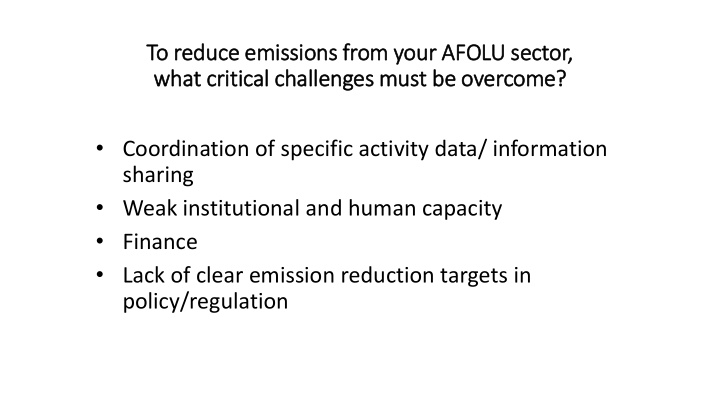



To reduce emis issions from your AFOLU sector, what crit itic ical chall llenges must be overcome? • Coordination of specific activity data/ information sharing • Weak institutional and human capacity • Finance • Lack of clear emission reduction targets in policy/regulation
What key actions and strategies must be in place? - RS NCCC CCCA Phase I - NSDP - SDP CC Policy CC Knowledge CC Trust Fund management Development 20 Grantees CCCSP SCCSP Adaptation SCCAP CCCA Phase II Grant NGGRM Facilities Low Carbon Governance and NPGG Development Transparency initiatives/Mitigation Human and NSPGG technological capacities CDM NAMA GREEN Other Mechanism JCM REDD+ GROWTH NCGG IGES, OECC, NGOs, Public & Private Sectors…
How wil ill these be fi finance? 1. Analysis of existing management and financing mechanism 2. Entry points for CC mainstreaming in management and financing mechanism
1. ANALYSIS OF EXISTING MANAGEMENT AND FINANCING MECHANISMS MAFF has shortlist 29 actions from its long list with 186 actions proposed. Based on its shortlist action, the total costs of the proposed actions for the next five years are estimated with US$ 206,003,000 (two hundred six million and three thousand USD). Key sources of financing overseen by the secretariat working group on Agriculture, Forestry and Fisheries (SCAFF) government annual budget allocation, loan and grant from multilateral banks such as from World Bank/ Asian Development Bank (SPCR program), International Financial for Agricultural Fund (IFAD), European Union, various bilateral aids, Official Development Assistant (ODA), Global Climate Fund mobilized by various UN agencies and from private sector. Based on preliminary climate change financing framework updated by the CCCA, there are potential ceiling cost for climate fund for the ministry with USD 122 (of which US$ 86 million expect for adaptation) from 2014-2018. The climate finance can significantly be increased through mainstreaming the climate aspect into usual development projects. This is achievable through greater awareness of the implication and impact of climate change is every mainstream sector. Although the magnitude of awareness is rather wide, it varies among sectors within the ministry. For example, the association of climate change is more obvious to stakeholders in sectors such as forest, energy, irrigation, agriculture, and disaster, but less in other sectors.
2. ENTRY POINTS FOR CLIMATE CHANGE MAINSTREAMING IN MANAGEMENT AND FINANCING MECHANISMS Based on the analysis in the previous section, this section include a description of steps to be taken to include climate change in the regular planning and budgeting tools of the ministry (sector strategies, PIP, budget strategic plan, NSDP submission, annual work plans, programme budgets. Box below is the summary of budget cycles for Cambodia ministry in submission for budget allocation. Box 1: The Budget Cycle Budget Strategy Paper (March-May). The budget process starts in the first week of March, when MEF prepare the Mid-term Macroeconomic and Public Finance Policy (MMPFP) in line with national development policy. The MMPFP is developed based on a prognosis of macro- economic variables (GOP growth and inflation, balance of payments, money growth and the exchange rate) and provides a forecast of the total resources available to government over the medium term. The MMPFP is submitted to the CoM for approval and is then used as the basis for the preparation of a Budget Strategy Paper (BSP). A circular on preparation of the BSP is issued by MEF Budget Department and line ministries and local authorities then prepare their submissions for the BSP and submit these to MEF by mid-May.
The BSP includes three year projections of spending for each ministry, and it is the foundation for: the linkage between the budget and policy, including the Rectangular Strategy and NSDP; the calculation and justification of budget needs; the sustainability of programmes; and the evaluation of the budget package and budget appropriation. The BSP is the tool for line Ministries to prepare their medium term and annual expenditure plans. The BSPs have a programmatic structure based on the identification of organisational objectives, budget activities, output targets and indicators for Ministry spending. At the moment, the BSPs only capture government resources. In the future, they will also include donor flows. One of the difficulties in incorporating donor funds into the BSPs is associated with the parallel modalities which are used to manage many donor projects. Budget Circular (June- September). Once the BSP has been approved, MEF drafts a circular on budget preparation, specifying the conditions and procedures to be followed. This is approved by the Council of Ministers and is then forwarded to line ministries and local authorities for drawing up detailed revenue and expenditure estimates to be submitted to MEF by July 25. In August, MEF consolidates the revenue and expenditure estimates and invites line ministries and local authorities to perform necessary adjustments before incorporating these into the draft Finance Law by September. Adoption of Budget (October-December). MEF submits the draft budget law to the Council of Ministers during the first week of October and to the National Assembly during the first week of November for approval. Finally, the draft budget law is submitted to the Senate by the first week of December and for adoption prior to December 25.
Recommend
More recommend